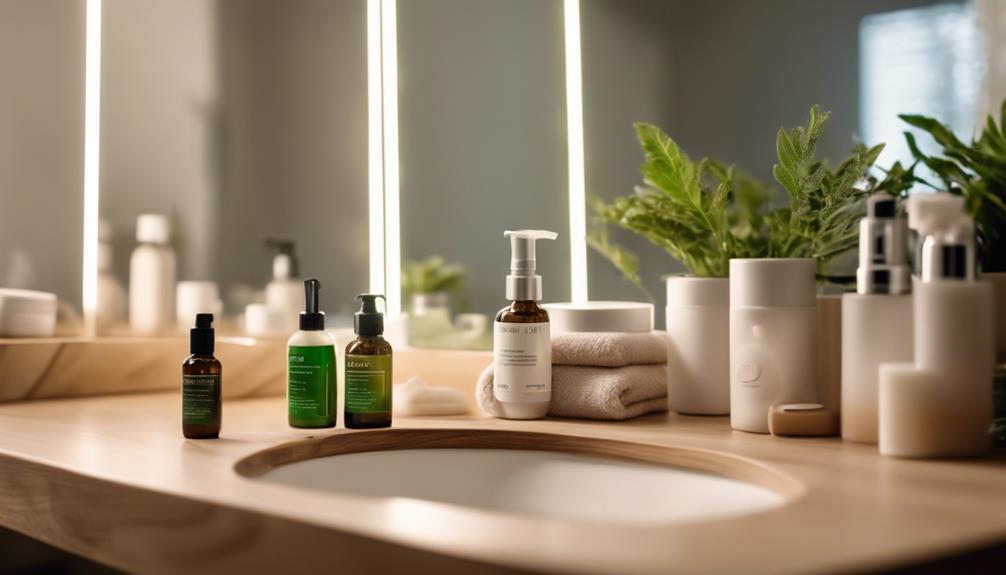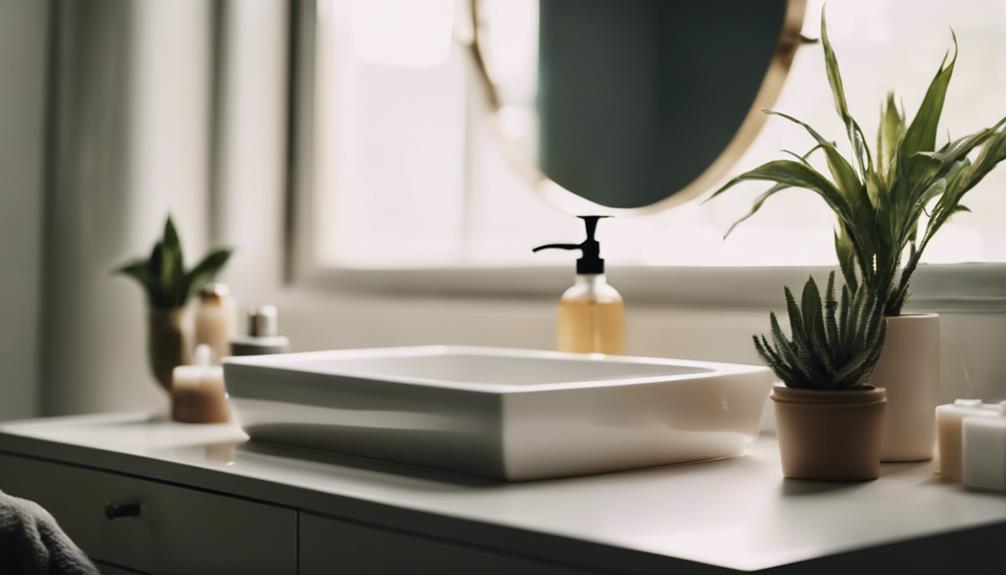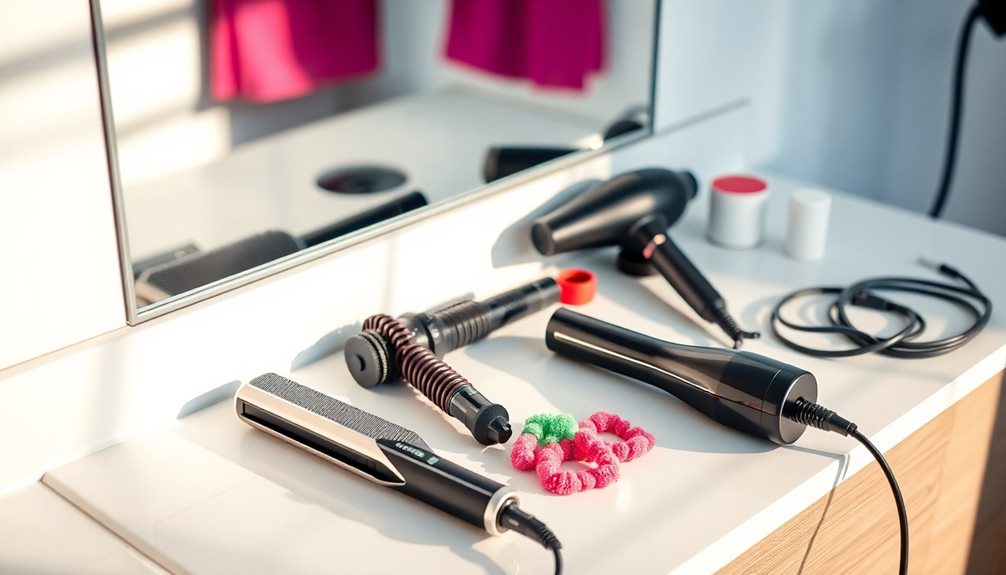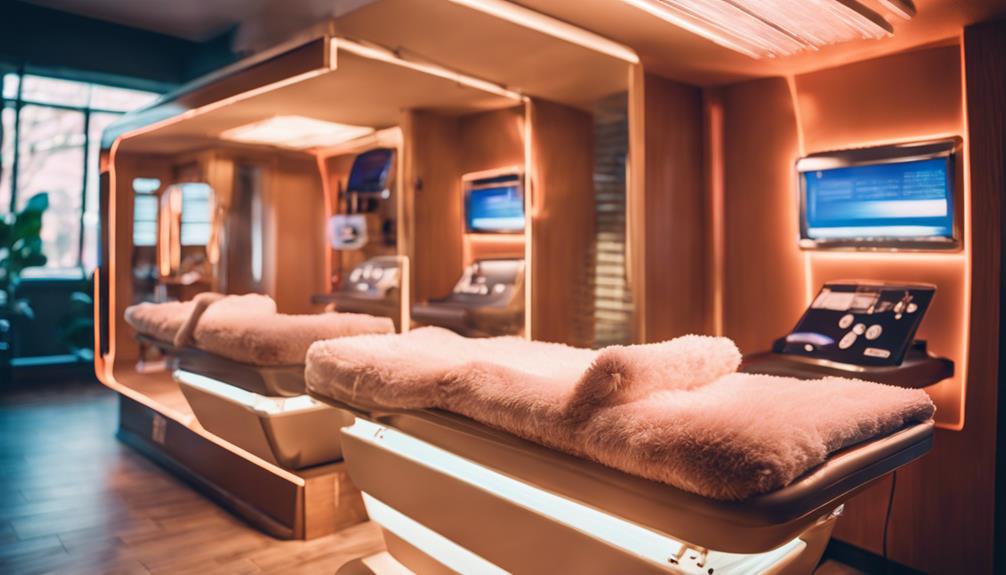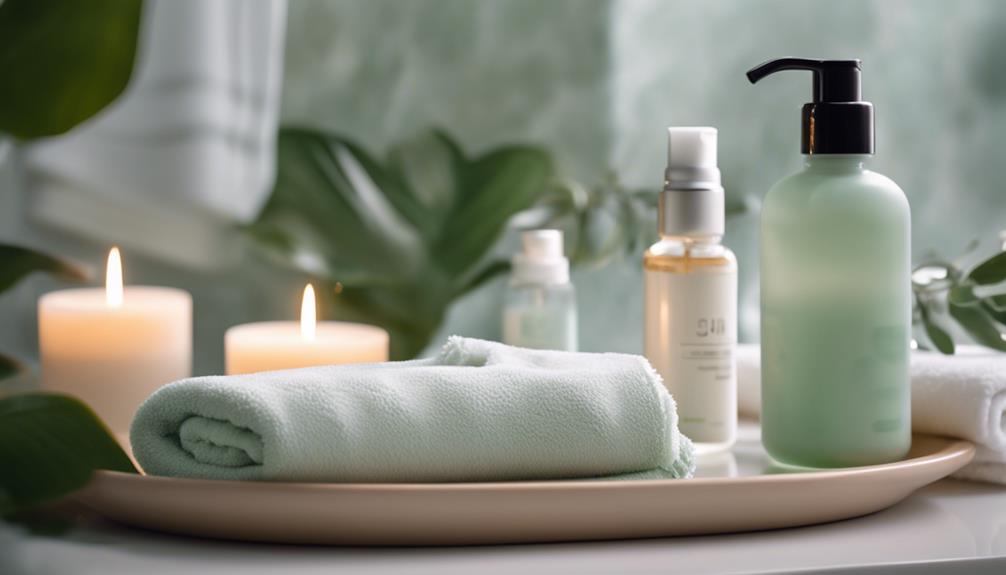To get clear skin, you should follow a consistent skincare routine specifically for managing acne. Start by using a gentle cleanser twice a day to clean your skin without causing irritation. Then, use targeted treatments such as salicylic acid or benzoyl peroxide on areas with acne. Don’t forget to moisturize with an oil-free moisturizer and apply broad-spectrum sunscreen during the day. Before bed, use a retinol serum to help with cell turnover. Stick to this routine for at least 6-8 weeks to see results. Interested in learning more tips to improve your routine? There’s a lot more to discover!
Key Takeaways
- Establish a consistent daily skincare routine, including cleansing, targeted treatments, and moisturization to effectively manage acne.
- Use gentle cleansers and non-comedogenic products to avoid irritation and prevent clogged pores.
- Incorporate targeted treatments like salicylic acid or benzoyl peroxide to unclog pores and reduce breakouts.
- Apply broad-spectrum sunscreen daily to protect sensitive skin and prevent hyperpigmentation.
Understanding Acne and Its Causes
Acne affects around 9.4% of the global population, making it a common skin condition that's often misunderstood. You might think that acne only impacts teenagers, but misconceptions abound. In reality, about 25% of men and 50% of women experience adult acne at some point in their lives. Understanding the causes is vital for achieving clear skin.
The primary culprits behind acne are inflammation, clogged follicles, bacteria, and excess sebum. When your skin produces too much oil, it can mix with dead skin cells, leading to clogged follicles. This creates a breeding ground for bacteria, which can further aggravate inflammation and worsen your breakouts. Hormonal fluctuations, particularly during your menstrual cycle or periods of stress, can also contribute to these issues, causing flare-ups that may seem relentless.
It's essential to debunk the myths surrounding acne triggers, like the belief that chocolate or greasy foods are to blame. Instead, focusing on a solid skincare routine tailored to your skin type can help manage these factors effectively. By understanding acne's causes, you can take proactive steps to promote clearer, healthier skin.
Mechanism of Acne Formation
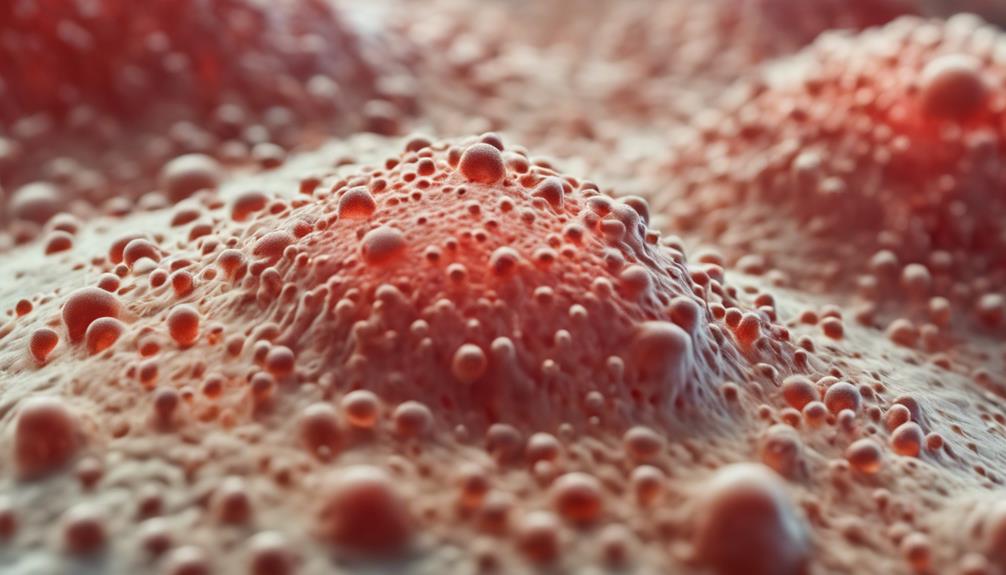
The overproduction of sebum by sebaceous glands plays an essential role in forming acne by clogging hair follicles and creating an ideal environment for bacteria to thrive. When hair follicles become clogged, it sets off a chain reaction leading to inflammation and various types of acne lesions.
To understand how acne forms, consider these key factors:
- Sebum Production: Excessive sebum can lead to clogged hair follicles, which is a primary cause of acne.
- Hormonal Fluctuations: Changes in hormones during puberty or menstrual cycles can increase sebum production and worsen breakouts.
- Bacterial Growth: Clogged follicles create a breeding ground for Propionibacterium acnes, a bacteria linked to acne.
- Inflammation: Your body's immune response to this bacterial growth results in inflammation, leading to painful bumps and lesions.
Recognizing these mechanisms is vital for developing targeted treatment strategies. By addressing the root causes of breakouts, you can work towards achieving clear skin and reducing the frequency of acne flare-ups.
Understanding this process empowers you to make informed choices about your skincare routine.
Importance of a Consistent Skincare Routine
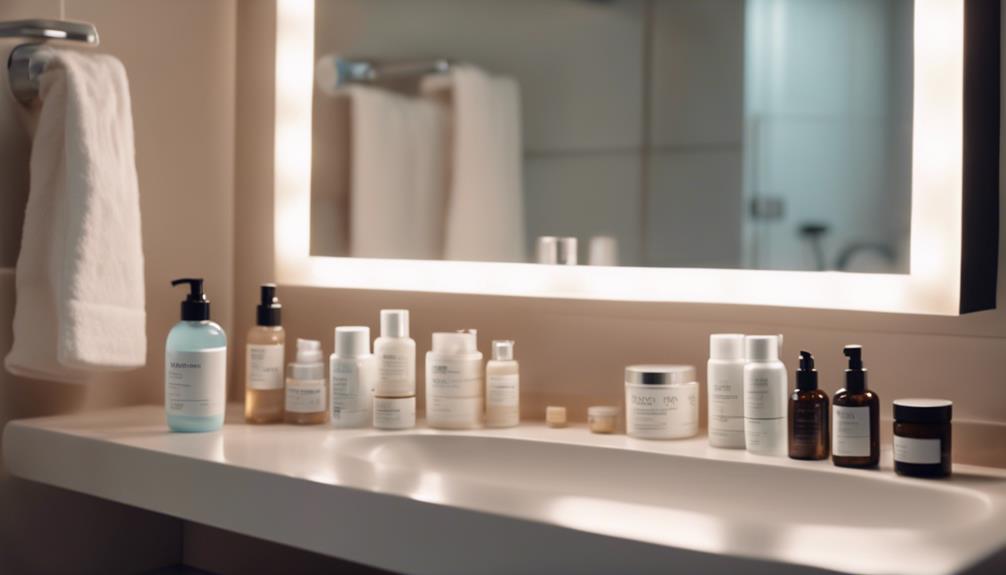
A consistent skincare routine is key to minimizing acne flare-ups and improving your skin health.
By sticking to a daily regimen, you can effectively manage existing breakouts and prevent new ones from forming.
Regular use of targeted treatments and gentle products not only keeps your skin clear but also boosts your overall confidence.
Minimize Acne Flare-Ups
Maintaining a consistent skincare routine is essential for minimizing flare-ups and keeping your skin clear. When you apply treatments irregularly, you risk increased breakouts and inflammation.
To effectively manage your acne, consider these steps:
- Use Non-Comedogenic Products: Opt for products that won't clog your pores, as this is vital for preventing acne flare-ups.
- Incorporate Active Ingredients: Regularly include benzoyl peroxide or salicylic acid in your routine to target acne-causing bacteria and clear clogged follicles.
- Establish a Gentle Cleansing Regimen: Cleanse your skin twice daily to remove dirt and excess oil, ensuring ideal product absorption.
- Tailor Your Routine: Choose treatments and products suited to your individual skin types, as what works for one person may not suit another.
Consistent use of these strategies not only helps reduce breakouts but also supports skin healing and barrier function.
The American Academy of Dermatology highlights the importance of a balanced routine for managing existing acne and preventing new breakouts. Stick to your skincare routine, and you'll likely see significant improvements over time.
Improve Skin Health
Consistent skincare not only helps manage acne flare-ups but also greatly improves overall skin health. By committing to a consistent skincare routine, you can reduce acne flare-ups by up to 50%. This is achieved by maintaining skin health and preventing clogged pores, which are essential for acne-prone skin.
Incorporating gentle, non-comedogenic products into your daily regimen supports your skin barrier, allowing it to function at its best. Regular cleansing removes impurities, while moisturizers hydrate without adding excess oil. Targeted treatments can further improve skin texture, addressing specific concerns like post-acne marks and uneven tone.
Stick to your routine for at least 6-8 weeks to effectively assess how these products impact your skin. This consistency not only addresses current breakouts but also minimizes the risk of future acne.
Essential Skincare Products for Acne
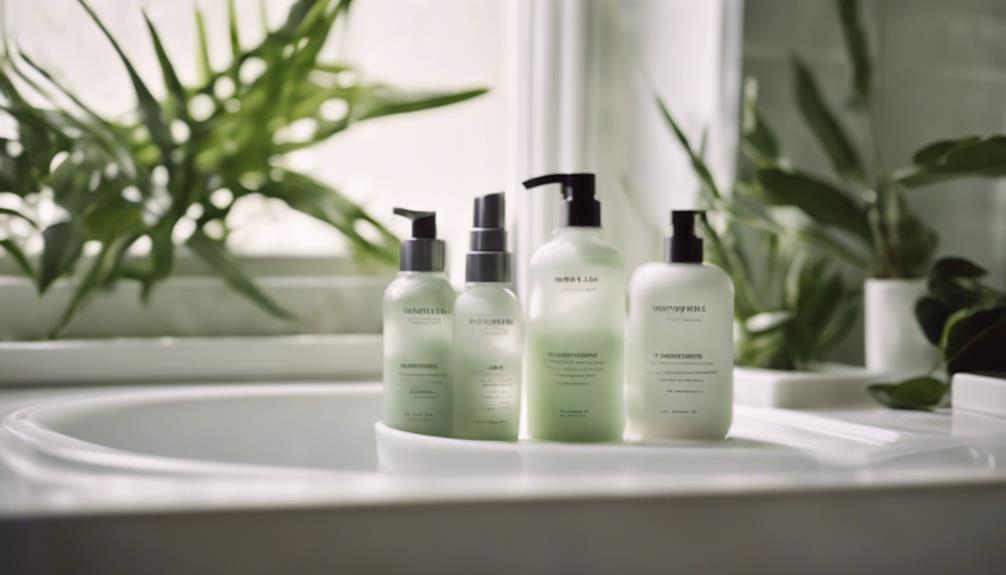
Effective skincare for acne-prone skin relies on using non-comedogenic products that hydrate while preventing clogged pores. To achieve clear skin, it's important to incorporate effective skincare products that target acne specifically.
Here's a list of must-have items:
- Salicylic Acid or Benzoyl Peroxide Treatments: These ingredients help unclog pores, fight bacteria, and promote skin cell turnover, making them essential for treating active breakouts.
- Exfoliating Acne Treatment: Use a gentle AHA or BHA exfoliant 2-3 times a week to remove dead skin cells and improve skin texture, reducing the likelihood of future breakouts.
- Non-Comedogenic Moisturizer: Choose a moisturizer like CeraVe PM Facial Moisturizing Lotion. This product contains ceramides and hyaluronic acid to maintain your skin's barrier without causing additional acne.
- Broad-Spectrum Sunscreen: Daily application of broad-spectrum sunscreen is crucial, especially when using treatments that can increase your skin's sensitivity to the sun.
Morning Skincare Routine Steps
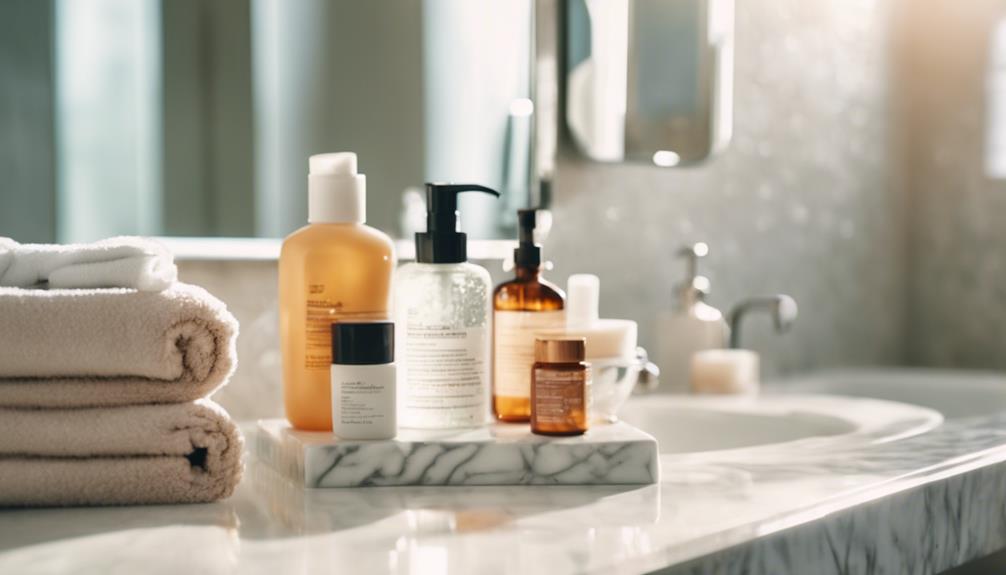
To kick off your morning skincare routine, you'll want to start with gentle cleansing techniques that won't irritate your skin.
Next, apply targeted treatments to tackle any breakouts directly.
Gentle Cleansing Techniques
Starting your morning with a gentle, non-irritating cleanser sets the foundation for a healthy skincare routine that helps combat acne. Using the right product, like CeraVe Acne Foaming Cream Cleanser, which contains benzoyl peroxide, effectively dissolves dirt and excess oil while clearing acne.
Here are some effective cleansing techniques to take into account:
- Cleanse Twice Daily: Stick to a routine that includes gentle cleansing in the morning and evening to remove impurities without stripping your moisture barrier.
- Avoid Harsh Scrubs: Over-cleansing or using abrasive scrubs can irritate your skin, exacerbating acne and causing inflammation.
- Post-Cleanse Hydration: Apply a hydrating toner after cleansing to balance your skin's pH and prep it for treatment products.
- Watch for Acne Flare-Ups: Consistent cleansing helps prevent the buildup of oil and bacteria, reducing the risk of acne flare-ups throughout the day.
Targeted Treatment Applications
After cleansing your face, apply targeted acne treatments containing salicylic acid or benzoyl peroxide directly to problem areas for best results. This step is essential in your skincare routine, as these active ingredients effectively address existing breakouts.
Start with a gentle cleanser like CeraVe Acne Foaming Cream Cleanser, which uses benzoyl peroxide to remove dirt and excess oil while maintaining your skin barrier.
Once you've applied your targeted acne treatments, follow up with an oil-free moisturizer. Look for one enriched with hydrating hyaluronic acid and ceramides to keep your skin moisturized without clogging pores.
This will help prevent dryness, a common issue when using acne treatments.
Hydration and Protection
Begin your morning skincare routine with a gentle cleanser that effectively removes impurities without stripping your skin of its natural moisture. This step is essential for maintaining balance in acne-prone skin.
After cleansing, focus on hydration and protection to keep your skin clear and healthy.
- Apply an oil-free moisturizer: Choose a lightweight, non-comedogenic product to help hydrate while preventing clogged pores. The CeraVe AM Facial Moisturizing Lotion is an excellent option, as it also provides broad-spectrum sun protection.
- Incorporate a targeted acne treatment: If you have existing blemishes, use a product with salicylic acid to address those issues while prepping your skin for hydration.
- Ensure daily sun protection: This is critical, especially when using acne treatments that can increase skin sensitivity to UV rays. Protecting your skin helps prevent post-inflammatory hyperpigmentation.
- Monitor your skin's response: Pay attention to how your skin reacts to the products. Adjust as needed to maintain hydration without compromising clear skin.
Nighttime Skincare Routine Steps
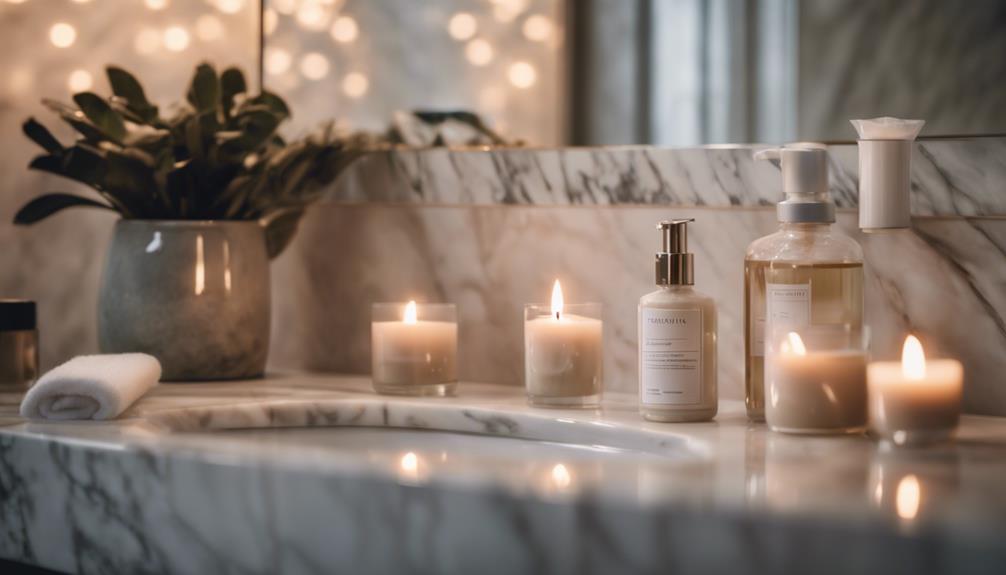
Cleansing your face with a gentle cleanser is the first step in an effective nighttime skincare routine for acne-prone skin. Start with the CeraVe Acne Foaming Cream Cleanser, which contains benzoyl peroxide to help clear existing acne while preserving your skin's moisture barrier.
Next, apply the CeraVe Resurfacing Retinol Serum. This product promotes skin cell turnover, reducing post-acne marks and enhancing your overall skin texture. Finally, finish with the CeraVe PM Facial Moisturizing Lotion. It hydrates the skin overnight without clogging pores, ensuring you wake up with a refreshed complexion.
Here's a quick overview of the steps:
| Step | Product | Purpose |
|---|---|---|
| Cleanser | CeraVe Acne Foaming Cream Cleanser | Clear existing acne |
| Retinol | CeraVe Resurfacing Retinol Serum | Promote skin cell turnover |
| Moisturizer | CeraVe PM Facial Moisturizing Lotion | Hydrate the skin |
Consistency in your nighttime skincare routine is essential. By following these steps nightly, you'll give active ingredients the chance to work effectively, leading to clearer, healthier skin over time.
Additional Tips for Clear Skin

To achieve clearer skin, incorporate non-comedogenic products into your routine to help prevent clogged pores. These products are specifically designed to avoid blocking your skin's follicles, reducing the risk of acne flare-ups.
Here are some additional tips to enhance your skincare routine:
- Always apply sunscreen: Daily use of broad-spectrum sunscreen protects your skin from UV damage and prevents post-inflammatory hyperpigmentation, especially when using acne products.
- Focus on moisture: Hydrate your skin with a lightweight, non-comedogenic moisturizer to balance oil production and maintain moisture to your skin.
- Practice stress management: Engage in activities like yoga or meditation to lower cortisol levels, which can help reduce inflammation and excess sebum production.
- Maintain a balanced diet: Consume foods rich in omega-3 fatty acids and antioxidants to support skin health and potentially clear acne by reducing inflammation.
Are the Skincare Strategies for Acne Effective in Clearing Your Skin?
Struggling with acne? Achieving clear skin with effective steps is possible. By consistently using gentle cleansers, non-comedogenic products, and spot treatments, you can see improvements. Additionally, maintaining a healthy diet and staying hydrated can aid in reducing breakouts. Stick to your skincare strategies for clearer skin.
Conclusion
Incorporating a consistent skincare routine can make a huge difference in your battle against acne.
Did you know that about 85% of people between the ages of 12 and 24 experience some form of acne?
By understanding your skin and using the right products, you can join the ranks of those who've achieved clearer skin.
Stick to your routine, be patient, and remember that with time, dedication, and the right strategies, you can conquer acne once and for all!
